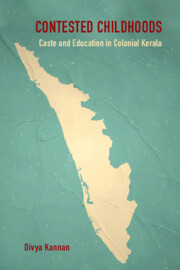5 - Debating Compulsion
Published online by Cambridge University Press: 28 November 2024
Summary
The introduction of measures to promote mass vernacular education ushered in significant shifts in the educational landscape of colonial Kerala from the mid-nineteenth century onwards, which indigenous and mission schools had hitherto dominated. These developments provided an impetus to the emergence of a ‘public’ sphere and a concomitant debate on notions of ‘publicness’ during this period. The right to access government schools, increasingly seen as ‘public’ in nature, was far from universal and constituted a major claim for subaltern communities in their quest for dignity. At the beginning of the twentieth century, upper-caste and upper-class pupils dominated government schools in the region, as some monarchical subjects were granted protection and guarantee of rights based on their caste status. In contrast, others were barred from entry and confined to separate, marginal spaces. d
By the 1890s, the shifts in modes of governance, led by the executive hand of the dewan subject to the ultimate authority of the monarch, witnessed several individual reformers, journalists, and caste and religious associations advocate for participation in an inclusive public sphere as rights-bearing subjects in Travancore and Cochin. Alongside struggles for temple entry, government employment, and land ownership, education became a key component of mass mobilization, undermining the princely states’ claims to modernity and pushing the limits of citizenship. In particular, school-based literacy was viewed as central to individual and community progress, occupational mobility, and reform, all of which were central to rethinking the interconnected relationship between space, body, and the self.
As a result of the establishment of the Travancore Legislative Council (TLC) in 1888, with the TSMPA in 1904, and the Cochin's Legislative Council (CLC) in 1925 consisting of nominated official and unofficial members, schooling became firmly enshrined on the political agenda. In every annual meeting, members belonging to different interest groups, particularly mercantile and planters’ associations, caste and religious organizations, and nominated members from depressed and backward classes, stressed the need to improve welfare provisions and addressed the budgetary concerns related to an overall expansion in primary and secondary education. A consensus was also emerging that children across class lines should receive elementary schooling and that the government would establish schools or provide grants to private agencies willing to take on the responsibility.
- Type
- Chapter
- Information
- Contested ChildhoodsCaste and Education in Colonial Kerala, pp. 219 - 263Publisher: Cambridge University PressPrint publication year: 2025

